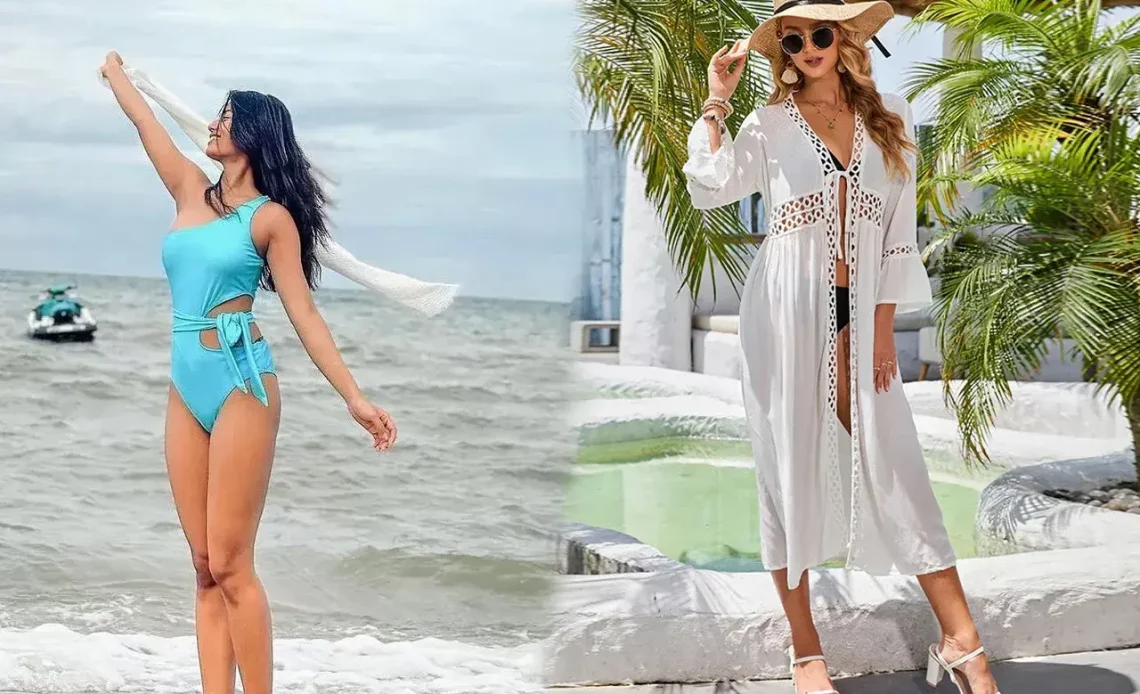
Table of Contents
The history of beach dresses is a fascinating journey that reflects the changing attitudes towards leisure, fashion, and cultural norms. While today’s beach dresses are synonymous with comfort and style, their origins are rooted in a time when swimwear was more about practicality and modesty.
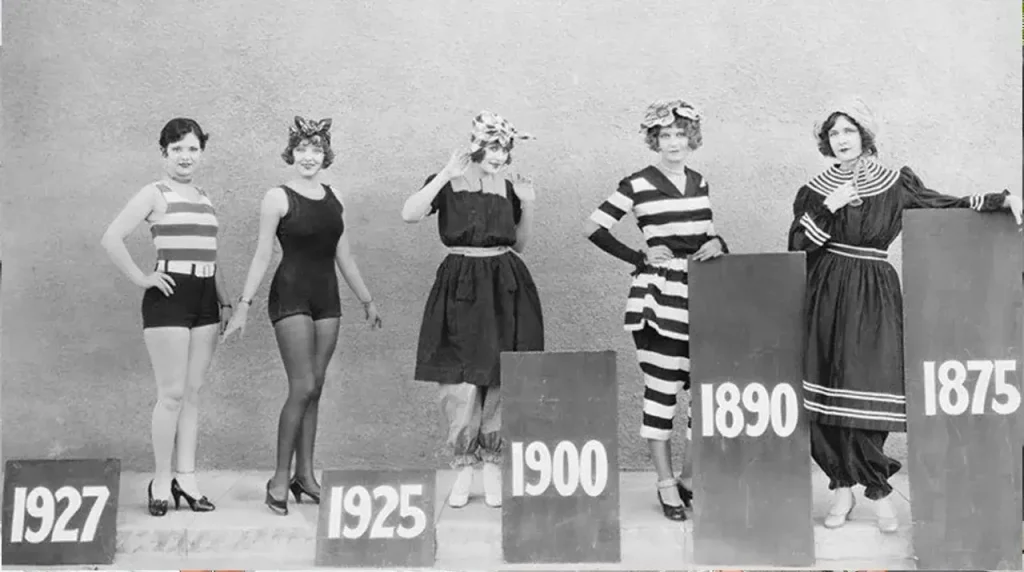
Early Beach Attire: From Modesty to Freedom
In the 19th century, beach attire was more about preserving modesty than making a fashion statement. Women’s bathing costumes consisted of heavy, cumbersome garments that covered them from head to toe. These bathing gowns were often made of wool or flannel and were designed to conceal the female form. Modesty was paramount, and women were expected to adhere to strict societal standards even when enjoying leisure activities like swimming.
The Dawn of Beachwear Liberation
The early 20th century witnessed a shift in attitudes towards beach attire, thanks in part to the rise of the suffrage movement and changing perceptions of women’s roles in society. With the introduction of knitted swimwear in the 1920s, beachwear began to undergo a transformation. Women embraced shorter hemlines and form-fitting silhouettes, signaling a departure from the heavy, restrictive garments of the past.
The Bikini Revolution: A Bold Statement
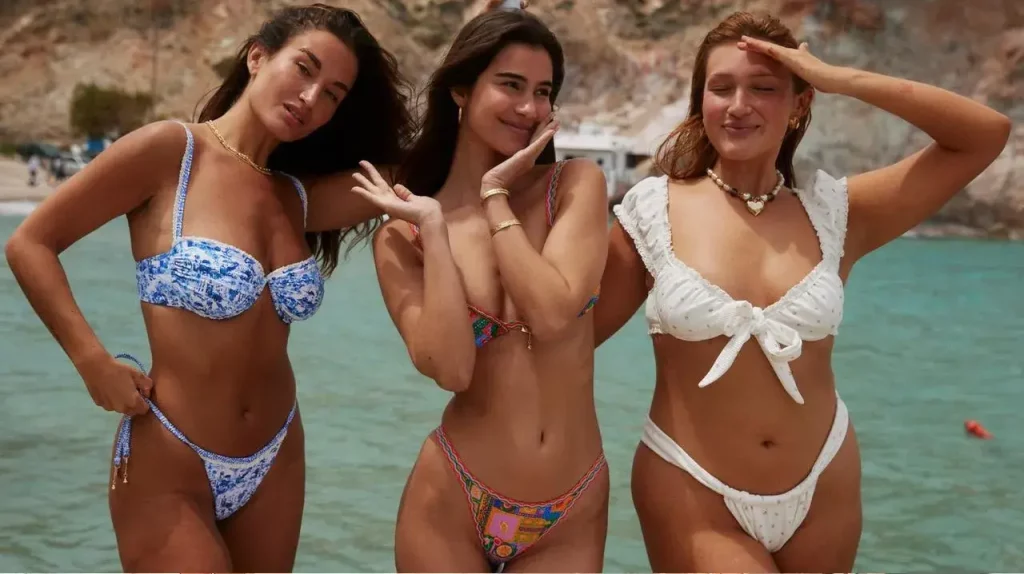
Perhaps one of the most iconic moments in the history of beachwear is the introduction of the bikini in the 1940s. Designed by French engineer Louis Réard, the bikini caused a sensation with its daringly revealing design. The two-piece swimsuit challenged traditional notions of modesty and femininity, sparking controversy and debate. Despite initial resistance, the bikini soon became a symbol of liberation and empowerment for women around the world.
The Influence of Hollywood and Pop Culture
Throughout the 20th century, Hollywood played a significant role in shaping trends in beachwear. Movie stars like Marilyn Monroe and Brigitte Bardot popularized glamorous, figure-hugging swimsuits that accentuated their curves and epitomized beachside chic. Beachwear became synonymous with sophistication and glamour, as women sought to emulate the style icons of the silver screen.
The Rise of Beach Culture: From Surfing to Sunbathing
The post-war era saw the emergence of beach culture as a vibrant and dynamic subculture. Surfing gained popularity in California, inspiring a laid-back, carefree aesthetic characterized by board shorts, bikinis, and Hawaiian prints. Meanwhile, sunbathing became a popular pastime, as people flocked to beaches to soak up the sun and enjoy the outdoors.
Modern Beach Dresses: Comfort meets Style
Today, beach dresses come in a wide range of styles, from breezy sundresses to elegant maxi dresses. Made from lightweight, breathable fabrics like cotton and linen, modern beach dresses offer both comfort and style. Whether you’re lounging by the pool, strolling along the shore, or attending a beach wedding, there’s a beach dress to suit every occasion and taste.
The Evolution of Beachwear
The evolution of beachwear is a captivating narrative that mirrors the societal shifts in attitudes towards leisure, body image, and gender roles. From the early days of cumbersome bathing costumes to the sleek and stylish ensembles of today, the journey of beachwear reflects a constant quest for comfort, functionality, and fashion.
Early Beach Attire: Practicality Over Style
In the 19th century, beach attire was more about practicality than fashion. Women’s bathing costumes were often heavy, ankle-length dresses made of wool or flannel. These garments were designed to provide modesty and protection from the sun, rather than making a fashion statement. Men’s swimwear, meanwhile, typically consisted of one-piece suits or shorts made of heavy fabrics like wool.
The Birth of Modern Swimwear
The early 20th century witnessed a shift towards more practical and streamlined swimwear. With the advent of new materials such as jersey and elastic, swimsuits became lighter, more form-fitting, and easier to move in. Women’s swimsuits featured shorter hemlines and sleeveless designs, while men’s swimwear evolved into the classic trunk-style shorts that we still see today.
The Roaring Twenties: A Decade of Change
The 1920s marked a significant turning point in the evolution of beachwear. With the rise of the leisure class and the popularity of seaside resorts, swimwear became more stylish and glamorous. Women embraced sleeveless, knee-length swimsuits made of figure-hugging materials like jersey and silk. Men’s swimwear also became more form-fitting, with shorter inseams and bold patterns.
The Golden Age of Hollywood: Glamour and Sophistication
The 1930s and 1940s saw the influence of Hollywood on beachwear fashion. Movie stars like Esther Williams and Ava Gardner epitomized glamour and sophistication in their stylish swimsuits and cover-ups. The bikini, introduced in the late 1940s, revolutionized beachwear with its daringly revealing design, challenging traditional notions of modesty and femininity.
The Swinging Sixties: A Fashion Revolution
The 1960s ushered in a fashion revolution that transformed beachwear into a symbol of liberation and self-expression. The bikini became a staple of the era, as women embraced its bold and provocative style. Men’s swimwear also underwent a transformation, with the introduction of shorter, tighter-fitting trunks inspired by the burgeoning surf culture.
The Rise of Athleisure: Comfort and Performance
In recent decades, beachwear has evolved to prioritize comfort and performance, reflecting the growing trend of athleisure. Technical fabrics like Lycra and polyester offer stretch, support, and quick-drying properties, making them ideal for active beachgoers. Rash guards, board shorts, and athletic-inspired swimsuits have become popular choices for those who enjoy water sports and outdoor activities.
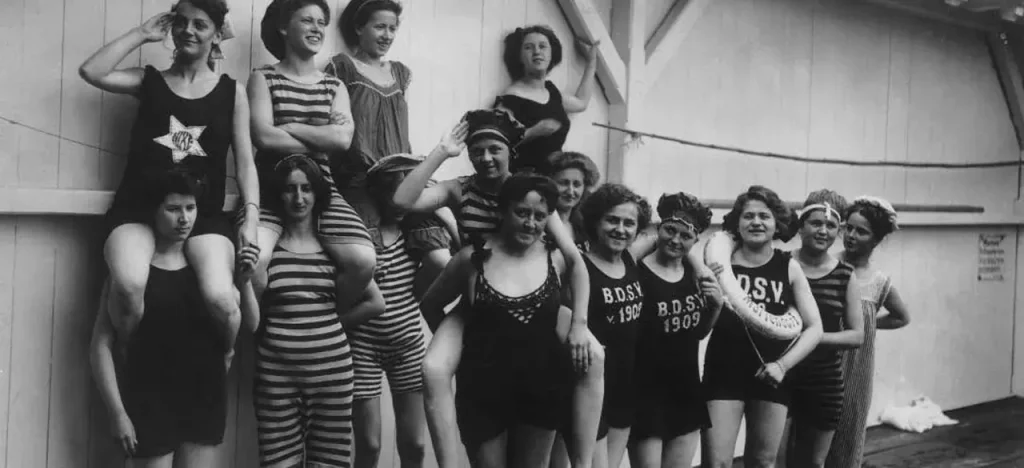
Cultural Influence on Beachwear
The evolution of beachwear is not just a story of fashion trends and technological advancements; it’s also deeply intertwined with cultural influences from around the world. From traditional customs to modern media, various cultural factors have shaped the way we dress for the beach, reflecting our values, identities, and sense of belonging.
Traditional Customs and Regional Styles
One of the most significant influences on beachwear is the rich tapestry of traditional customs and regional styles from different cultures. In many coastal communities around the world, beach attire reflects local customs, beliefs, and climate conditions. For example, in tropical regions like the Caribbean and South Pacific, loose-fitting garments made of lightweight fabrics are popular choices for beachgoers, providing protection from the sun while allowing for airflow and comfort. In contrast, in colder climates like Scandinavia and Northern Europe, thicker materials and layered clothing are more common for beach outings, reflecting the need for warmth and insulation.
Colonialism and Globalization
The spread of colonialism and globalization has also played a significant role in shaping beachwear trends. As European powers expanded their empires across the globe, they brought with them their own customs, fashion sensibilities, and ideas about leisure. The adoption of Western-style swimwear in colonial territories often reflected a desire to emulate the perceived sophistication and modernity of Western culture. Over time, these borrowed styles merged with local traditions, creating unique hybrid forms of beachwear that are still evident in many parts of the world today.
Media and Popular Culture
The influence of media and popular culture cannot be overstated when discussing the cultural impact on beachwear. From Hollywood movies to fashion magazines, the portrayal of beach scenes and stylish swimwear has shaped our perceptions of what is considered fashionable and desirable. Iconic images of movie stars like Marilyn Monroe and James Bond emerging from the surf in glamorous swimsuits have become timeless symbols of beach chic, inspiring generations of beachgoers to emulate their style. Similarly, the rise of social media influencers and celebrity endorsements has further amplified the influence of popular culture on beachwear trends, as people seek to replicate the looks of their favorite stars and trendsetters.
Cultural Identity and Expression
For many people, beachwear is more than just clothing; it’s a form of cultural identity and expression. Whether it’s a traditional sarong worn by women in Southeast Asia or a brightly colored pareo worn by Polynesian dancers, beach attire often reflects cultural heritage, values, and symbols. In multicultural societies, beachwear can serve as a powerful means of expressing pride in one’s ethnic identity and connecting with others who share similar cultural backgrounds. Additionally, beach festivals and events celebrating specific cultural traditions provide opportunities for people to showcase their unique styles and customs, fostering a sense of community and belonging among participants.
The Diversity of Beach Dresses
When it comes to beach dresses, there’s no shortage of styles to choose from. From breezy sundresses to elegant maxi dresses, each type offers its own unique blend of comfort, functionality, and style, catering to different preferences and body types. Let’s delve into the diverse world of beach dresses and explore the characteristics of each type.
Sundresses: Effortless Elegance
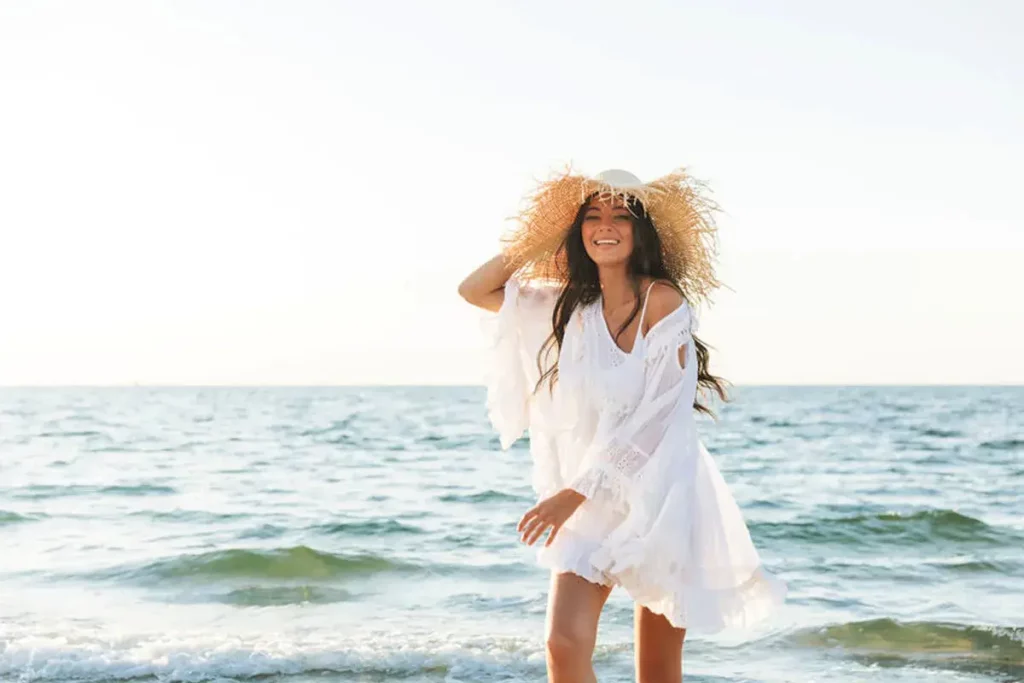
Sundresses are the epitome of easy-breezy summer style. Characterized by their lightweight fabrics, sleeveless designs, and flowy silhouettes, sundresses are perfect for soaking up the sun on a hot summer day. These dresses often feature playful patterns, such as floral prints or geometric motifs, adding a touch of whimsy to your beach ensemble. Sundresses come in a variety of lengths, from mini to midi to maxi, allowing you to choose the perfect length to suit your comfort and style preferences.
Maxi Dresses: Bohemian Chic
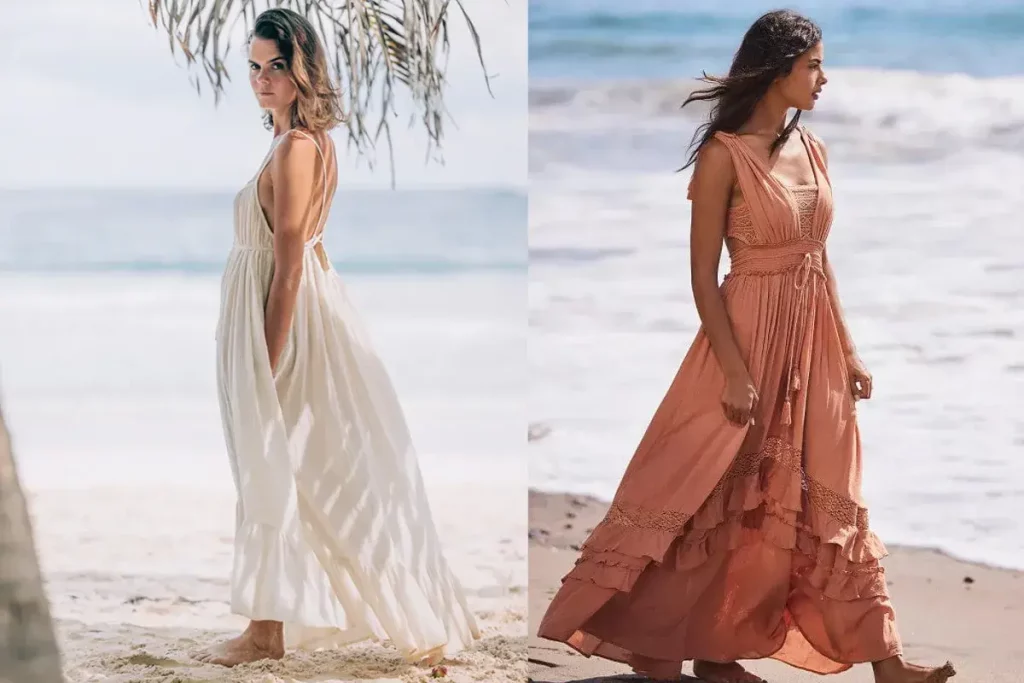
For those who crave a bit more coverage and drama, maxi dresses are the perfect choice. These floor-length dresses offer a sense of effortless elegance with their billowing skirts and sweeping hemlines. Maxi dresses come in a range of fabrics, from lightweight cotton to luxurious silk, making them versatile options for beachwear. Whether you opt for a simple solid color or a bold print, maxi dresses exude bohemian chic vibes, making them ideal for beach weddings, sunset strolls, or lounging by the pool.
Cover-ups: Versatile and Practical
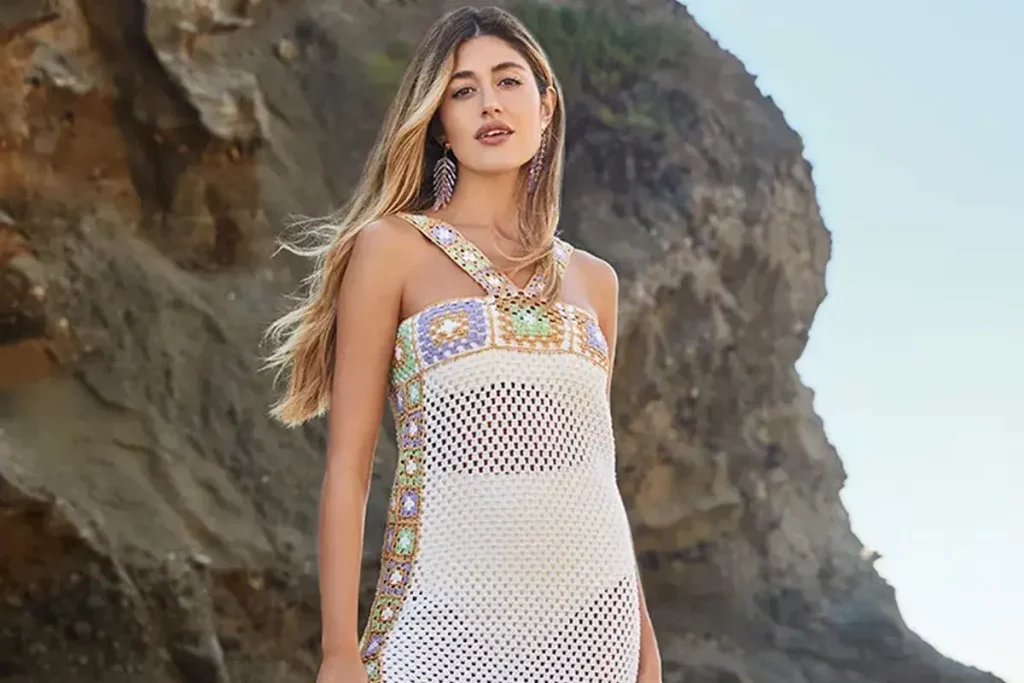
Cover-ups are essential pieces in any beach wardrobe, providing coverage and protection while still allowing you to show off your swimsuit underneath. These versatile garments come in various styles, including kaftans, sarongs, tunics, and beach robes, offering something for every taste and occasion. Cover-ups are typically made from lightweight, quick-drying fabrics like cotton or chiffon, making them perfect for throwing on over a wet swimsuit. Whether you’re heading to the beach or grabbing lunch at a seaside cafe, a stylish cover-up is a must-have accessory for any beach outing.
Wrap Dresses: Flattering and Feminine
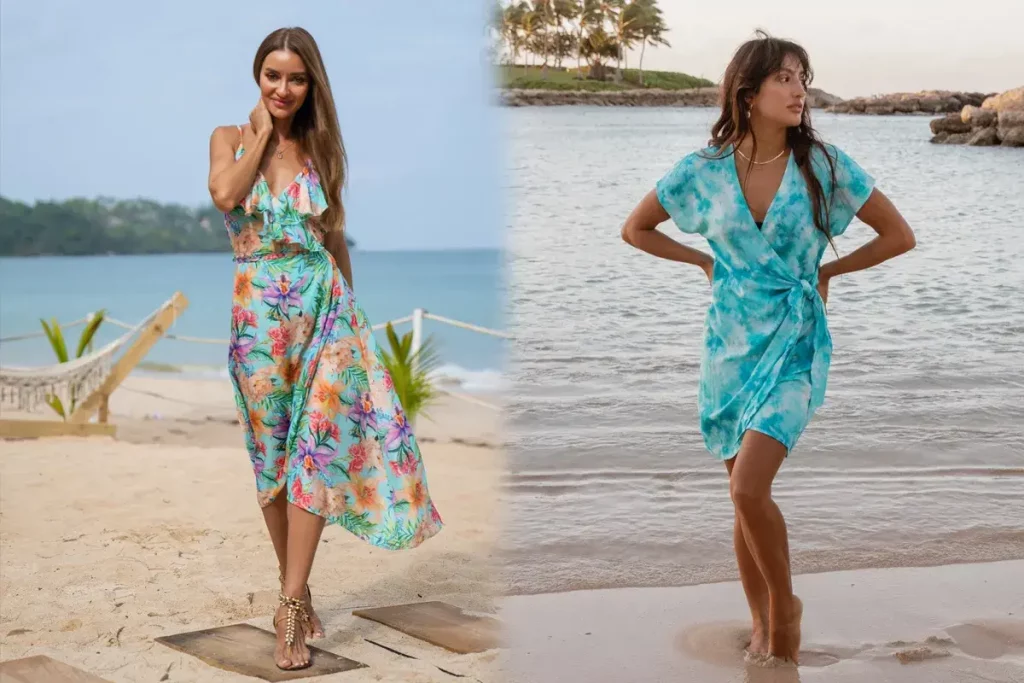
Wrap dresses are universally flattering and effortlessly feminine, making them a popular choice for beachwear. These dresses feature a wrap-around design that cinches at the waist, creating a flattering silhouette that accentuates curves and elongates the body. Wrap dresses come in various lengths and sleeve styles, allowing you to choose the perfect option for your body type and personal style. Whether you prefer a classic solid color or a bold, tropical print, a wrap dress is sure to turn heads wherever you go.
The Selection Process: Choosing the Right Beach Dress
Selecting the perfect beach dress can be both exciting and daunting, as you want to find a balance between comfort, style, and functionality. Whether you’re lounging by the pool, sipping cocktails at a beach bar, or strolling along the shoreline, the right beach dress can make all the difference in your overall beach experience. Here’s a guide to help you navigate the selection process and choose the perfect beach dress for your needs.
Body Type Considerations: Flatter Your Figure
When choosing a beach dress, it’s essential to consider your body type and select a style that flatters your figure. Different dress silhouettes suit different body shapes, so it’s important to identify your body type and choose a dress that accentuates your best features. For example, if you have an hourglass figure, opt for a fitted dress that highlights your curves. If you have a pear-shaped body, choose a dress with an empire waist to draw attention to your upper body while minimizing the hips. Understanding your body type can help you make informed choices and feel confident and comfortable in your beach dress.
Fabric and Material: Keep Cool and Comfy
The fabric and material of your beach dress play a crucial role in determining its comfort and functionality. When shopping for a beach dress, opt for lightweight, breathable fabrics like cotton, linen, or rayon that will keep you cool and comfortable in the heat. These materials allow air to circulate, preventing you from feeling overheated or sweaty, even on the hottest summer days. Additionally, choose fabrics that dry quickly, such as polyester or nylon, to ensure that your dress stays fresh and dry, even after a dip in the ocean or a splash in the pool.
Occasion and Style: Dress for the Occasion
Consider the occasion and setting when choosing a beach dress, as different styles are suitable for different activities and environments. For a casual day at the beach, opt for a relaxed sundress or a flowy maxi dress that allows you to move freely and enjoy the sun and surf. If you’re attending a beach wedding or a fancy resort dinner, choose a more formal dress in a lightweight fabric like chiffon or silk that exudes elegance and sophistication. Pay attention to the dress code and theme of the event to ensure that your dress aligns with the occasion and reflects your personal style.
Styling Tips: Add the Finishing Touches
Once you’ve chosen the perfect beach dress, it’s time to add the finishing touches to complete your look. Consider accessorizing with statement jewelry, a wide-brimmed hat, or a colorful scarf to add personality and flair to your outfit. Choose footwear that is comfortable and practical for the beach, such as sandals, flip-flops, or espadrilles, that can easily be slipped on and off. Keep your hair and makeup simple and natural, opting for beachy waves and a sun-kissed glow that complements your beach dress and enhances your overall beach look.
Expert Styling Tips
Once you’ve chosen the perfect beach dress, it’s time to take your ensemble to the next level with some expert styling tips. From accessorizing to footwear and hair and makeup, these tips will help you create a beach look that is both chic and effortless, ensuring that you turn heads wherever you go.
Accessorizing: Add Flair and Personality
Accessories are the key to elevating any outfit, and beachwear is no exception. Choose accessories that complement your beach dress and add flair and personality to your look. Statement jewelry, such as bold earrings or a chunky necklace, can instantly jazz up a simple sundress or maxi dress. Opt for natural materials like wooden beads, shells, or woven straw for a beachy vibe that complements the seaside setting. Don’t forget to accessorize with a stylish sun hat or floppy beach bag to complete your look and keep your essentials close at hand.
Footwear: Stay Stylish and Comfortable
Choosing the right footwear is essential for a beach look that is both stylish and comfortable. Opt for sandals, flip-flops, or espadrilles that are easy to slip on and off and can withstand sand and water. Look for styles with sturdy straps and non-slip soles to ensure stability and support as you walk on uneven terrain. Consider embellished sandals or metallic flip-flops for added glamour, or go for classic leather espadrilles for a laid-back, bohemian vibe. Whatever you choose, make sure your footwear complements your beach dress and allows you to move freely and comfortably throughout the day.
Hair and Makeup: Keep It Simple and Natural
When it comes to hair and makeup for the beach, less is often more. Embrace your natural beauty and opt for a low-maintenance hairstyle that can withstand sun, wind, and water. Beachy waves are a timeless and effortless look that complements any beach dress, whether you have long, flowing locks or short, cropped hair. To achieve beachy waves, simply scrunch your hair with a sea salt spray and let it air dry for a tousled, textured look.
For makeup, keep it simple and natural with a lightweight, water-resistant foundation or tinted moisturizer that evens out your skin tone without feeling heavy or cakey. Add a touch of bronzer or blush to give your complexion a sun-kissed glow, and finish with a swipe of waterproof mascara and tinted lip balm for a fresh and polished look. Avoid heavy makeup or bold colors that can melt or smudge in the heat, opting instead for a soft and dewy finish that enhances your natural beauty and radiates beachside charm.
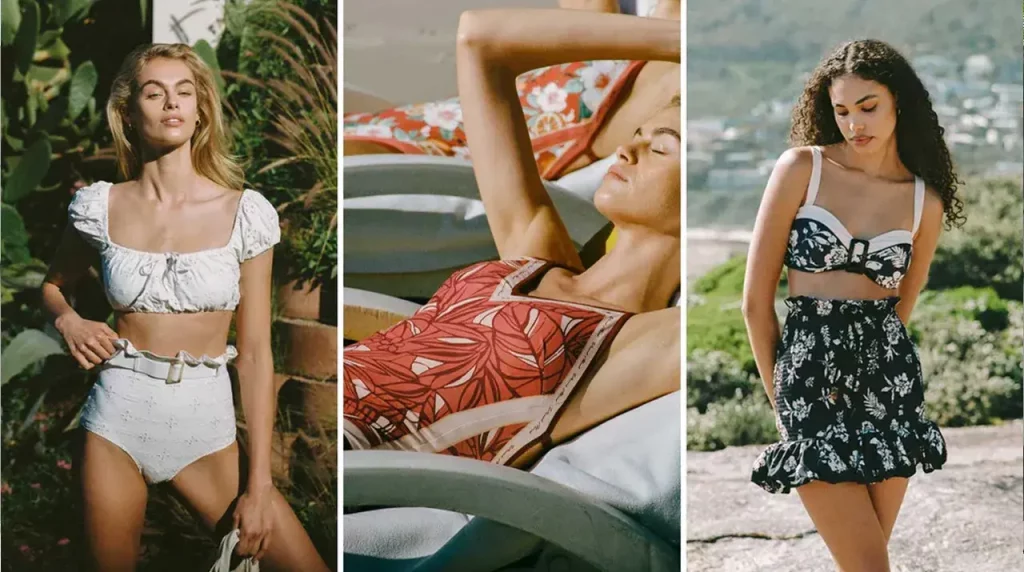
Embracing Sustainability: A Closer Look at Beachwear
As environmental awareness continues to grow, so does the importance of sustainability in every aspect of our lives, including fashion. Beachwear is no exception, with an increasing number of brands and consumers prioritizing eco-friendly materials and ethical practices. From eco-conscious fabrics to fair labor standards, sustainability in beachwear encompasses a range of initiatives aimed at minimizing environmental impact and promoting social responsibility.
Eco-friendly Materials: Embracing Innovation
One of the key pillars of sustainability in beachwear is the use of eco-friendly materials that minimize harm to the environment. Traditional materials like conventional cotton and polyester are resource-intensive to produce and can have a significant ecological footprint. In contrast, eco-friendly alternatives such as organic cotton, bamboo, and recycled fabrics offer a more sustainable option. These materials are grown and processed using fewer chemicals and resources, reducing pollution and waste in the production process. Additionally, innovative materials like Econyl®, a regenerated nylon made from recycled ocean plastic and other waste materials, are gaining popularity in beachwear for their environmental benefits and performance properties.
Ethical Practices: Putting People First
In addition to eco-friendly materials, sustainability in beachwear also encompasses ethical practices that prioritize the well-being of workers and communities throughout the supply chain. Fair labor standards, safe working conditions, and living wages are essential components of ethical manufacturing practices, ensuring that workers are treated with dignity and respect. Many sustainable beachwear brands partner with factories and suppliers that adhere to internationally recognized labor standards, such as the Fair Labor Association (FLA) or the Ethical Trading Initiative (ETI), to ensure transparency and accountability in their operations.
Transparency and Traceability: Building Trust
Transparency and traceability are key principles of sustainability in beachwear, allowing consumers to make informed choices about the products they buy and the brands they support. Many sustainable beachwear brands provide detailed information about their supply chain and manufacturing processes, including the origins of their materials, the locations of their factories, and their environmental and social impact assessments. By being transparent about their practices and policies, brands can build trust with consumers and demonstrate their commitment to sustainability and accountability.
Consumer Education and Empowerment: Driving Change
Consumer education and empowerment are essential drivers of change in the sustainable fashion movement, including beachwear. By raising awareness about the environmental and social impacts of fast fashion and promoting sustainable alternatives, consumers can make more conscious choices about the products they buy and the brands they support. Many sustainable beachwear brands engage in consumer education initiatives, such as workshops, webinars, and social media campaigns, to empower consumers with knowledge and resources to make sustainable choices.
Conclusion
Beach dresses are more than just garments; they are a reflection of cultural trends and personal style. Whether you prefer a casual sundress or an elegant maxi dress, there are endless options to choose from. By considering factors such as body type, fabric, and occasion, you can find the perfect beach dress to suit your needs.
FAQs
- Can I wear a beach dress for non-beach occasions?
- Absolutely! Many beach dresses are versatile enough to be worn for other occasions, such as brunch or shopping.
- How do I care for my beach dress?
- Check the care instructions on the garment label, but in general, most beach dresses can be machine washed on a gentle cycle and hung to dry.
- Are cover-ups only for wearing over swimsuits?
- While cover-ups are designed to be worn over swimsuits, they can also be styled as regular dresses or tops for casual outings.
- What accessories pair well with beach dresses?
- Accessories such as floppy hats, straw bags, and shell jewelry complement beach dresses beautifully.
- Can I wear heels with a beach dress?
- While you can technically wear heels with a beach dress, it’s not recommended for beach outings as they can be impractical and uncomfortable on sand. Stick to flat sandals or espadrilles instead.
